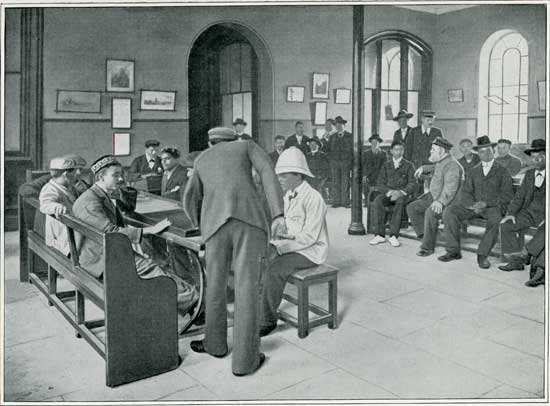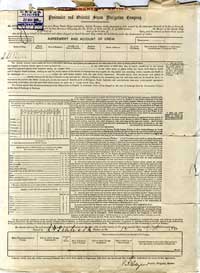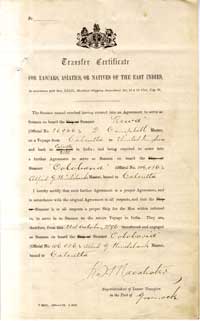“ Remainder of Crew...”

Although we have reproduced several Agreements from the MHA that refer to Asiatic seafarers, the “More Than a List of Crew” team has been unable to identify a distinctive Board of Trade form amongst Memorial’s holdings. Asiatic Agreements were instead sanctioned by the Governor-General of India in Council. It now presumes there was no generic Asiatic Agreement for Lascars. Our best insight comes from the RGSS. It is clear from what Henry Malan said to the 1902-1903 committee that at least for a time he had access to Asiatic Agreements (MM Committee 1903, Minutes, Q. 12065). The process by which he aggregated the numbers of Asiatic seafarers aboard British-registered vessels arriving at British ports was similar to that by which he arrived at the annual total for all British-born and foreign seafarers, and this meant consulting the Agreement (Burton 1985, 307-308). But the similarities end here. A British seafarer seeking redress for the infringement of employment conditions could call upon the RGSS to produce their articles: the Asiatic seafarer could not pursue similar claims in like manner. And so, quite simply, there was no necessity for any Agreement that was opened and closed under Indian mercantile marine law to find a permanent home with the RGSS. The irony is that officials at the Board of Trade were in regular contact with its Lascar transfer agents in British ports and with consuls abroad and perhaps nowhere, not even in Havelock Wilson’s headquarters, was there a greater consciousness of the infringements on such rights that Lascars possessed under Indian statutes (BT Instructions to MMO Superintendents 1891, 67).

The Lascars who met in Bombay in 1902 and primed Chichgur of their case that their employers should be put under no pressure to change their working conditions also suggested he make the Committee on the Merchant Marine mindful of one more thing, that they, the Lascars of Bombay and seafarers of the Empire, were the originators of the document of identity that vouched for a seafarer being the individual he claimed. They wanted the Committee to know that Asian seafarers had their certificates of identity even before the Continuous Discharge Book was introduced at British ports (MM Committee 1903, Minutes, Q. 9223). But despite this bid to transcend their insularity, Lascar certificates remained just that, documents that were tenable only in Indian ports, and brokered only through the agents who controlled access to employment on the Lascar articles of British steamship companies. One of the Discharge Books can be seen reproduced in Caroline Adams’s study, but this was secured from a settler, a subject in her Lascar oral history life story project (Adams [1987] 1994, 138). The people who were most likely to retain uncollected Books were the Ghat Serangs at Bombay, Calcutta or other Indian port, which is why we have no expectation of finding one amongst the Agreements amassed by the RGSS in London. A chance survival would have to be explained: by what circumstances did it come to be in the Archive, and does its survival cause us to modify our understanding of what the Lascar employment system created, a pervasive, persistent and flexible system of labour (Ewald 2000, 462) for the steamship companies recruiting at ports in Asia and the Middle East?

Asiatic Agreements are different from Discharge Books. They do exist in the MHA, albeit in fewer numbers than we consider ideal to initiate a full-scale research project aimed at understanding Lascars’ experience of seafaring based only at this location. The form in which they exist is mostly as special company Agreements. Identifying and examining them goes on, and with each discovery we look both to the internal evidence they present of Lascar terms of employment and then for what their survival reveals about the institutional and business practices applied to Lascars.

Among the most fruitful of concerns to have emerged since positivist visions of the past were displaced is that with “the presence of absence”. In treating race (and gender) historians are often concerned with what is unmarked save by its shadowy presence. On her first visit to Memorial, the Africanist Janet Ewald identified a handful of lists of Lascar names amongst the MHA Agreements (Ewald 2000, 81-86). From these she confirmed an African migrant presence at Indian and Middle Eastern ports. More recently she elaborated on patterns of mobility by sea and how they were linked with emancipation from slave status. Further, Ewald has gone on to provide a rich picture of ethnic and geo-political differentiation within the Lascar workforce (Ewald 2010, 452-458).
Meanwhile one of the most innovative historians of India currently writing about Lascars has briefly turned his attention to the Log Books that are occasionally preserved with Agreements. Gopalan Balachandran holds out rather little hope of finding anything in these sources, at least anything that might see his questions directly answered (Balachandran 2008, 53). We do not dispute the official bias of these sources. Nevertheless, Balachandran’s key proposition that Lascars prevailed in circumstances where outwardly they were denied agency needs an empirical starting point. The Logs and Agreements should not be passed over: they offer a start on what he has identified as the need to tell a different story “from below”, different from that which has already been told of either British seafarers or of Indian workers ashore.
As we continue to ask why did this particular Asiatic Agreement in its whole, or in part, come to be with the RGSS, and what bearing do the terms and conditions it specifies for Lascars have on its survival, we are trying to grasp the dynamic and mobile relationship of state, capital, and labour across an empire that left many of its workers disenfranchised. To be sure, we recommend tuning in to the histories that are found outside official archive space, for there, as well, there is sense to be made of the legal and labour regimes impinging on Lascars (Adams 1994).
